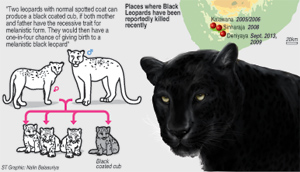News
Dark secrets of a black beauty
Rudyard Kipling’s ‘Jungle Book’ refers to a black panther, Bagheera. This was really a black leopard and even though Badheera was fictitious, black leopards do exist. But are their days numbered in Sri Lanka, is the question that many wildlife enthusiasts pose.

Brutal end: The carcass of the black leopard
Another black leopard faced a brutal death in Deniyaya a few days back. Its decomposing body was recovered from a forest patch close to Handford Estate, in the village of Thalapalakanda.
Veterinary surgeon Dr.Tharaka Prasad who conducted the post-mortem said the animal would have died an agonising death after succumbing to internal wounds sustained on getting caught in a wire snare. Poachers had cut off both its forelimbs and a large portion of flesh from its neck area. Even the teeth and claws of the remaining limbs of this black beauty had not been spared.
Wildlife officers were however puzzled that no attempt was made to skin the animal as its coat would have fetched a high price. They believe the animal would have got caught in a trap set for wild boars. But conservationist and leopard researcher, Rukshan Jayawardane who went to the site with Dr. Prasad said the trap may have been set up deliberately to snare the black leopard – or other leopards that frequent the area. He has urged police to find the culprits. There is a local belief that leopard flesh taken from an area that cannot be licked by the animal is good for asthma patients and wearing its claws and teeth a sign of bravery.
Kokila Harindra, wildlife range officer of Kaluthota who was alerted by Deniyaya police said villagers had complained about the stench from a rotting carcass of a leopard. He said the villagers had not spotted the black leopard before. The animal was a mature male leopard about 7 foot long, Mr. Harindra said.
Dense forest: Safer habitat for rare black leopard
In 2009, a black leopard was entrapped in a wire trap in the vicinity of Deniyaya. A few years ago there was was a report of the death of another black leopard in the area of Sinharaja. Dr. Prasad said in the past six years the Department of Wildlife Conservation received reports of 16 leopard deaths in and around Sinharaja.

The fact that of them three were black leopards means there could be more in the area, Dr.Prasad said adding that they were initiating a study on these rare species. Childers Jayawardane, a wildlife officer wrote about sighting a black leopard as far back as 1948 in Yala Block III. He also recalled seeing another black leopard at Banawalkema 30 years later.
However, black leopard sightings have not been recorded recently in the dry zone, and it is believed that the darker environs of a dense forest helps the black leopard to survive, says Rukshan Jayawardane. Pointing out that there maybe more leopards outside the protected wildlife areas he pointed out that conservation programmes should encompass these areas too.
Anjali Watson – a leopard researcher who has studied leopards in the wet zone and the hill country says the biggest threat to leopards in general and the rare black species is the lack of protected areas in the wet zone and hill countries unlike in the dry zone. As a result habitat fragmentation, poaching and indirect snaring can go unnoticed.
She said black leopards even in other countries are found mainly in dense forest areas. The reason being the darker and more secluded habitat of rain forests allow a melanistic leopard to survive more easily and reproduce, passing on the recessive gene of melanism. In the dry zone where the habitat is more open they are less likely to survive into adulthood.
Who are these black beauties?
The black leopard belongs to the same species of leopards found in Sri Lanka, scientifically known as Panthera pardus kotiya. This species has been tagged as ‘Endangered’ by Red List 2012.
What differentiates a black leopard from a normal leopard is its black coat that is a result of a condition called melanism where the dark-coloured pigment melanin in the skin develops. This is similar to the condition of an albino where the absence of melanin makes an animal lighter coloured.
Zoologists say this is caused by a melanistic recessive gene and on close inspection the usual leopard spots are visible even on a black leopard. Scientists also say two leopards with normal coats have a one-in-four chance of producing a black-coated cub, if both mother and father have the recessive trait for melanistic form. Other big cats such as jaguars who have this melanistic form are commonly referred to as black panthers.
comments powered by Disqus
